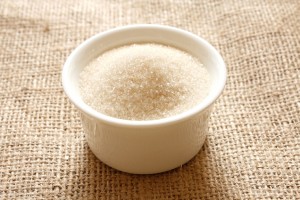


Sign-up for {N}power to get exclusive discounts, newsletters, members-only features, and more!

Sugar used to be considered a delicacy, a treat that was enjoyed only occasionally. But with the advent of the processed foods industry, sugar made its way into every nook and cranny of our food supply, and now it’s so ubiquitous that we’re often not even aware we are eating it. While a novelty coffee drink or slice of cake is an obvious sugar trap, many foods are not: Added sugar in bread? Check. Pasta sauce? Check. Canned soup? Check. Bacon?! Check. Baby formula?!! Yep. And the list goes on. In fact, about 75 percent of packaged food sold in the United States contains added sugar.[fn value=1][/fn]
Most sweeteners—table sugar, high-fructose corn syrup, maple syrup, honey—are composed of the simple sugars fructose and glucose in about equal  parts, with some variation, depending on the sweetener.
parts, with some variation, depending on the sweetener.
Glucose, also referred to as blood sugar, is either used as energy by cells or stored as glycogen for future use. Insulin is secreted by the pancreas in response to elevated blood glucose, helping glucose enter cells, thus lowering blood sugar levels.
While glucose can be metabolized by almost every cell in the body and used as fuel, fructose doesn’t produce an insulin response and is taken up primarily by the liver.[fn value=2][/fn] Because this avoids frequently recurring insulin spikes after any sugar consumption, fructose was suggested to be less harmful. Prepared foods and soft drinks in particular, but even purportedly healthy fruit juices, contain fructose as an artificial additive — often in high quantities. In addition, fructose is sweeter to the taste, potentially making it more addictive.[fn value=3][/fn] In recent decades fructose spread throughout the food market, due to a reputation as being less harmful than glucose and because high-fructose corn syrup is remarkably cheap.
But there’s a downside: when excess fructose makes its way into the blood stream, there is nothing for the body to do with it except convert it into fat and store it, a process that is largely dependent on the liver.[fn value=4][/fn]People who consume too much high-fructose food can in time become overweight and develop high blood pressure, dyslipidemia with fatty liver (non-alcoholic fatty liver disease) and insulin resistance — conditions that doctors group together under the name metabolic syndrome.[fn value=4][/fn] In fact, doctors are seeing non-alcoholic fatty liver disease in children as young as two! But to be honest, this is all somewhat old news.
New research published by Wilhelm Krek, a professor of cell biology at ETH Zurich’s Institute for Molecular Health Sciences, gives new insight into another, more troubling side effect of fructose.
The research group, which recently published their findings in the prestigious journal, Nature, describes a previously unknown molecular mechanism that points to fructose as a key driver of uncontrolled and unhealthy growth of the heart muscle. This can lead to a condition known as cardiac hypertrophy and can lead to fatal heart failure.
When the heart is taxed, such as when a person has high blood pressure, it must grow in order to pump blood through the circulatory system. In order to achieve this, heart cells rely on a process called glycolysis — literally, the ‘splitting of sugars’. If there is a plethora of fructose available to the heart cells in addition to glucose, this can set off a fatal chain reaction.
The central enzyme in fructose metabolism, ketohexokinase-C (KHK-C), was previously thought to be produced only in the liver, but it is now known that heart muscle cells also produce it, allowing heart cells to rely on fructose as a fuel source while growing.[5] Uniquely, unlike glucose metabolism, there is no molecular pathway to stop energy production via fructose once sufficient energy has been produced, starting a vicious cycle that can contribute to heart failure.[fn value=4][/fn] [fn value=5][/fn]
I’m eating a banana as I write this blog. Am I thinking twice about eating my banana? Is there a concern that we should stop eating fruit because of fructose? No!
Let’s be realistic: fruit is not where this excess fructose is entering our diets. Fruit contains plenty of important nutrients such as antioxidants, vitamins, and fiber. Numerous studies have provided convincing evidence that higher intakes of fruits and vegetables support health in a variety of fashions.[fn value=6][/fn] [fn value=7][/fn]The large and problematic volumes of fructose (mostly in the form of high-fructose corn syrup) are entering our diets because they are added to processed foods, especially to sweetened beverages and soft drinks. This has caused the consumption of high-fructose corn syrup in the USA to skyrocket. Beginning with its introduction over three decades ago, the consumption of high-fructose corn syrup has gone from 290 grams per person per year in 1970 to over 33 kilograms per person per year in the year 2000.[fn value=2][/fn] That fact alone suggests that simply avoiding foods containing high-fructose corn syrup can make a huge difference in your health.
So read that ingredients list twice. Be aware of what you are eating and drinking. The argument that fructose has the same metabolic effects as normal sugar is slowly beginning to unravel and this is just another piece of the pie.



Sign-up for {N}power to get exclusive discounts, newsletters, members-only features, and more!